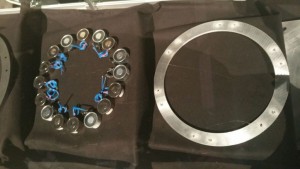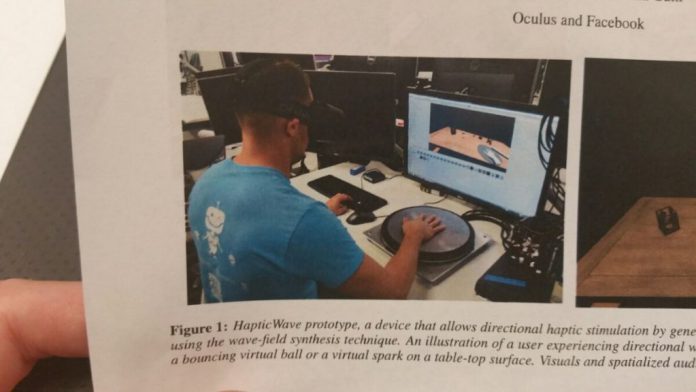Oculus VR presented the public debut of their HapticWave research at SIGGRAPH 2016.
Oculus VR’s research team recently revealed a new prototype device, the HapticWave, designed to push the envelope of player feedback during virtual reality (VR) experiences. Showcased at SIGGRAPH 2016 for the first time, HapticWave is suggested as having potential use cases in enhancing movie experiences, tactile perception research, multi-user collaboration and – perhaps most immediately – tabletop videogames.
The simple demonstration made available at the event was an adequate showcase of the potential of the device, but at the same time was inherently flawed. It’s apparent that the HapticWave is a far distant technology; not yet even close to discussing a potential consumer product. Just as with the first iteration of the Oculus Rift itself – a duct-tapped ski goggles headset that promised far more than it delivered – the HapticWave demonstrates how haptics can become an important part of the VR experience in the future.
Built using the Unity engine, the demonstration offered two effects in order for the user to determine what the device could achieve. Placing your hand on the HapticWave (presented by a white circle on a table in the virtual world) a bouncing ball was controllable via the arrow keys on a keyboard. The player can move the ball and upon each impact with the table would feel a vibration from the HapticWave. This is never a full-on shake as was the case in the late ’90s with the Nintendo 64’s Rumble Pak, nor a simple reaction to an in-game element as in the case of modern console and PC control pads. The HapticWave delivers subtle, precise clues as to the location of an object similar (and linked to) the head-related transfer function (HRTF) audio of the Oculus Rift itself.
Sadly, it’s not as precise as you might be expecting. Pushing the HapticWave to it’s limits, turning your head and feeling the vibration to determine where the ball might be without visual clues was a very hit-and-miss affair. For some currently unknown reason, positions above and to the right off the hand placement where far more accurate in haptic feedback – almost perfect in representation of position – than below or to the left. So much so, that at no point did any bounces in these latter positions accurately represent location without pairing with visual clues.
The second effect – a sparkler connected to the table and controlled in the same way – was far more precise. This created a constant vibration through which it was easier to determine movement and distance to your hand. The difference suggests that a constant build of vibration as the object approaches your hand delivers a more accurately interpretable sensation through the HapticWave than when intermittent, as with the bouncing of the ball.

Similar to Subpac technology or many force feedback devices of the 16-bit era, the HapticWave is based entirely on sound frequencies. It relates directly to frequencies sub-200hz, and as such an SDK for the device wouldn’t necessarily require proprietary code on behalf of the developer or synchronisation with a videogame engine. However, were Oculus VR, in time, to open up a later iteration of the device it would be hoped that developers would be able to input their own ruleset for haptic feedback. For example, falling rain and hail may sound similar, but should offer a very different physical affect.
The HapticWave is constructed of a number of layers to allow for the sensation of vibration feedback. An aluminium base plate hosts a series of electromagnets (16 in total) which are the only sound-reactive components. Above this is an aluminium support ring, a gum foam ring and at the very top a stainless steel ferrous plate, which is where the user places their hand. This combination of items is driven in real-time to provide a feedback sensation that collaborates with the visual presentation and HRTF audio cues from an Oculus Rift head-mounted display (HMD).
Unusually for an Oculus VR experiment, the HapticWave feels somewhat behind much of the competition. There’s little doubt that whatever form the eventual product using this technology takes it’s likely to be competitive to the point of pioneering, but at present the HapticWave is a coy look at the potential for haptic feedback, rather than an aggressive push for modernising the technology in parallel the Oculus Rift or the forthcoming Oculus Touch. Time will tell what will become of the HapticWave; at present little more than a subdued view of the future.















